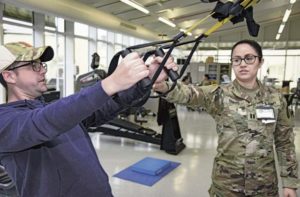
The occupational therapy office at Landstuhl Regional Medical Center does not look like a typical medical office. A row of exercise equipment occupies the brightly lit room along with a weight rack, a heated bin of what looks like sawdust, as well as various brightly colored instruments. There are tubs of putty and rolls of yellow, blue, green and red material; all the equipment in the office are tools for working on patients’ hands and arms.
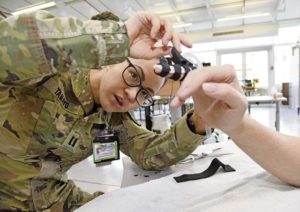
“Occupational therapy is a rehab profession aimed at helping anyone with a physical, mental or social illness, disorder or problem,” said U.S. Army Capt. Jacqueline Tamayo, LRMC occupational therapy assistant chief. “We help them work through those issues to interact with life as optimally as possible.”
Since there are fewer than 70 occupational therapists in the U.S. Army, Tamayo’s title is rare and may be misunderstood by those who are unfamiliar with this particular medical niche. Issues a patient would go to the occupational therapists at LRMC for include PTSD resulting from combat or sexual trauma, traumatic brain injury, wrist fracture, tendon laceration, a broken finger, and memory or movement problems resulting from a stroke.
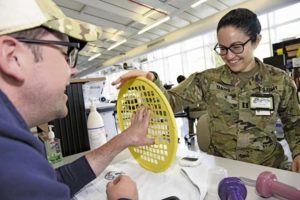
LRMC has three occupational therapy resources to help recovering patients accomplish everyday tasks. The orthopedic clinic helps with upper extremity bone and muscle issues. The traumatic brain injury clinic deals with TBI-related neurological issues involving upper extremities. The Evolutions Program helps post-traumatic stress disorder victims cope through activity-based groups.
The most common injuries Tamayo sees are through motorcycle incidents, which cause crush wounds and road rash, and tendon lacerations from cutting food or using a box cutter.
Also, personnel with desk jobs are prone to carpal tunnel and tendonitis.
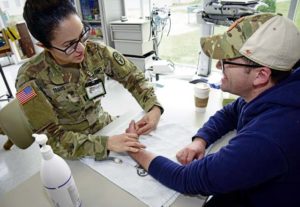
Much of Tamayo’s work involves evaluating and reassessing patients’ progress. She applies treatments and movement exercises until they are back to optimal function.
The foundations of occupational therapy have existed in different forms as early as 100 B.C. The practice was heavily influenced by the U.S. Army during World War I, when they were called reconstruction aides. By working off a doctor’s diagnosis, reconstruction aides would devise physical activities to get injured muscles working again.
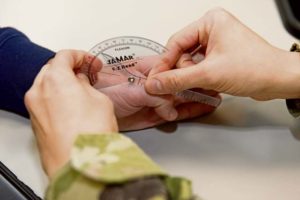
For a variety of reasons, occupational therapy is slightly different in the military today than in the civilian world. While the majority of the career field assists with a vast amount of daily troubles, Tamayo mainly addresses elbow, wrist and hand injuries and ailments. She is one of several LRMC OTs, but that is her specialty.
“In the last civilian job I had, I was seeing 22 patients a day and the question was always ‘why aren’t you seeing 25?’” Tamayo said.
While working in the Army, Tamayo has experienced the opposite and enjoys the freedom to give patients the amount of care they need.
For a referral to occupational therapy, contact the 86th Medical Group appointment line commercial at 06371-46-2273, or DSN 479-2273. For the LRMC appointment line, call commercial at 06371-9464-5762 or DSN 590-5762.







